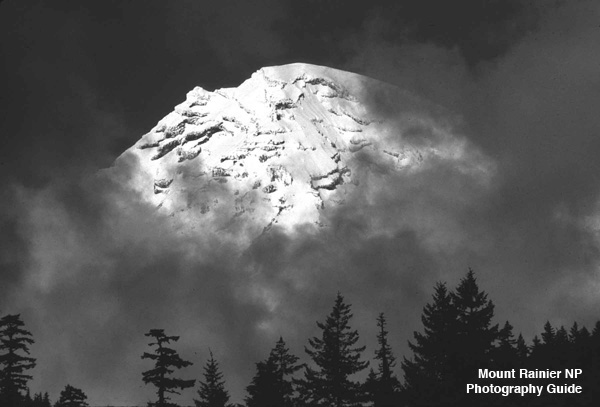

Bicycle Roads and Trails in Mt. Rainier NP
Find bike roads and trails via a map
MPG V2.8, January 2013
Few people consider Mt. Rainier National Park a place to ride a road or mountain bike, and for the most part they would be right since it's a destination for visitors, hikers, photographers, and others, but not riding a road or mountain bike in the NP. There are few places to do this and many restrictions where you can't.
It's that simple, but still there are some places in the NP and many places around the NP to ride a mountain bike and the highway and roads can be used to ride and see the park on a different scale and time frame. And here and on the map is where you can find resources and places if you bring your bike to the NP.
Road and Trails
There are two types of bike riding you can do in Mt. Rainier NP, road and mountain bikes and each have different places to ride in the NP.
Road Bikes
There are several highways for road bikes.
Highway 706.-- traverses the southern side of the NP from the Nisqually entrance in the southwest to Paradise and then to the Stevens Canyon entrance in the southeast. It has a 3,400 foot elevation gain over the 19 miles from the entrance to Paradise, and about the same elevation gain over 21 miles from the junction with highway 123 to Paradise, see note below.
Highway 123/410.-- traverses eastern side of the NP from the Ohanopecosh entrance in the southeast to Chinook and Cayuse passes and past the White River entrance to the northeastern boundary just south of the Crystal Mountain highway, see note below.
Road to Sunrise.-- starts at the White River entrance and travels to the White River campground and onward to the Sunrise visitors center. It has a 3,000 foot elevation gain over the 15-plus mile road from the entrance to the visitors center, see note below.
Notes.-- These highways are two-lane paved highways with slow to moderate speed limits, 35 mph on the NP roads and 55 mph on the eastside state highways (123 and 410), and while the eastside state highways are wide, the roads in the NP are narrow with few designated bike lanes, only wider shoulders in some areas with turnouts and vista way points.
Mountain Bikes
There are several roads and trails for mountain bikes.
The Westside road.-- is an unpaved road from highway 706 just east of the Nisqually entrance. The Westside road is 3.2 miles to the Dry Creek trailhead. This road is open seasonally for cars but closed from late fall to late spring and is an excellent low elevation gain ride in any weather in and a great ride out (all downhill).
The Westside Road ends at the first Fish Creek crossing, about a quarter mile past the Dry Creek trailhead. From there to the second crossing, about another quarter mile, the road is in the Tahoma Creek channel, is often flooded or flood damaged, and is not maintained. After the second crossing, the road becomes the Old Puyallup Road to the end of the road.
The Old Puyallup Road.-- is the continuation of the Westside Road past the Dry Creek trailhead, from the first Fish Creek crossing, over the half-mile of extremely rough trail to the second Fish Creek crossing, and the remaining 5.6 mile road Round Pass to Klapatche Point where it ends and bikes are only allowed on the road and are prohibited on all trails.
The Mowich Lake road.-- is an unpaved US Forest Service (USFS) road off highway 167 to the Mowich Lake entrance and the additional 5 miles to the lake and campground. It is open seasonally from early summer to late fall, all dependent on the onset of snow in the fall and and winter and the snowmelt in the spring.
It's a good low, gentle elevation gain to and into the NP. You should be alert for traffic both direction during the season the road is open at the NP to Mowich Lake and the campground and trailhead, usually early July to October. During the winter beware of traffic during bad weather and snowmobiles when snow is present on the road.
The Carbon River road.-- was severly damaged in the winter storms of 2006 and 2008. The NPS closed the road to all vehicles at the entrance, only open to hikers and bikes. The bikers are restricted to the Carbon River trail, and not other trails, to the Ipsut campground, five miles from the entrance. The road and trail is currently being reviewed for alternatives for visitors, but mountain bikes will continue to be allowed on the Carbon River road and trail.
Other Roads and Trails
Areas around the NP.--There are numerous bike roads and trails in the USFS lands around the NP, many listed in the books listed below. These are usually USFS roads shared with cars or trails shared with hikers, so you should use caution when riding to avoid cars and not injure hikers. All USFS lands requires a recreation permit to park and use the lands, see their Web page for more information.
Additional Resources
Below are additional books and Websites with information on mountain bike trails in and around Mt. Rainier NP.
- Books in Print
- Websites
Please use the contact link to send e-mail.